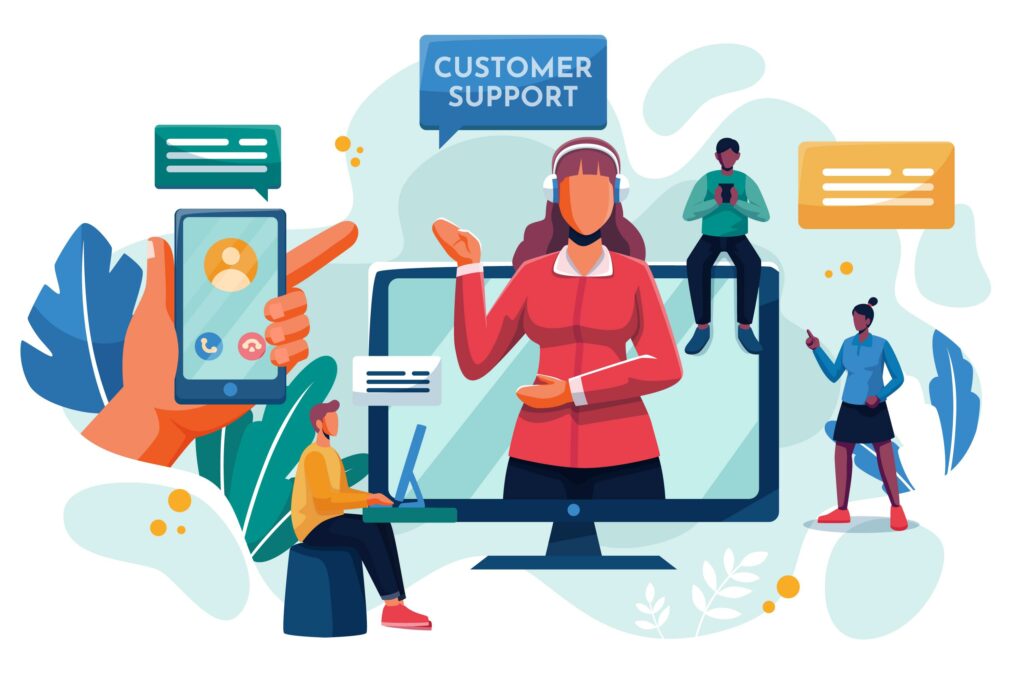When you outsource customer service, means you are entrusting your customer care to an external agent. They will have the potential to substantially reduce overhead costs, resulting in savings of both money and resources and often alleviating a significant amount of stress.
However, it is crucial to recognize that it is not a universally applicable solution, and there are no miraculous outsourcing shortcuts available to simplify the process. Therefore, it is imperative to carefully assess your alternatives, particularly when an external company may be directly engaged in interactions with your customers.
Outsource Customer Service
Outsourcing customer support means using the services of a third-party provider to manage your customer service needs. The quality of customer support outsourcing varies widely. The issue lies in the dissatisfaction that arises from engaging with scripted contact center agents who struggle with language barriers, leading to circular conversations.

Nobody appreciates waiting lengthy phone wait times, repeated calls, or the challenge of resolving issues. However, it’s important to note that not all outsourcing experiences are characterized by low cost, scripted interactions, and frustration. The top-tier outsourcing providers excel in delivering friendly, empathetic, and effective support agents, aiming to drive strategic improvements and consistently delight customers.
When to outsource customer service
Outsourcing customer service can be a great idea in certain situations. Here are some cases where it makes sense:
1. When you need to handle changes quickly:
If your business is growing fast or going through changes, outsourcing keeps the quality of service high and ensures quick responses. This is especially helpful in industries like retail and e-commerce where support needs fluctuate with seasons.
2. When you want to scale your business:
Outsourcing helps you maintain good customer service even when your business is rapidly growing. It ensures you can focus on your company’s direction while still providing that personal touch your customers love.
3. When you need to manage costs:
For startups, outsourcing customer support is often more cost-effective than hiring an in-house team. It eliminates various expenses like salaries, workspace, and benefits, saving you money.
4. When you aim to improve customer experience:
If your reports show areas for improvement in customer service, outsourcing can work closely with your team to make things better. Key factors to consider include first contact resolution, response time, ticket volume, resolution time, customer satisfaction, and retention.
8 Tips for Successful to outsource customer service

1. Set Clear Goals:
Start by defining clear and SMART goals (Specific, Measurable, Attainable, Relevant, and Time-bound). This could involve reducing customer wait times, improving first response times, or enhancing customer loyalty and retention.
2. Think About Your Customer:
Consider where your support partner fits into your operations. Define the problems they should address, the solutions they’ll provide, and when to direct customers elsewhere.
3. Establish Your Tone:
Ensure your third-party partner speaks in harmony with your brand voice. Clearly communicate brand guidelines and provide examples during training to maintain a seamless customer experience.
4. Consider Legal and Security Aspects:
Review legal and security requirements as your partner will handle sensitive customer information. Have your legal team scrutinize the selection before finalizing any contracts.
5. Find the Right Partner:
Select a partner aligned with your customer service approach and quality standards. Consider factors like language, call center technology, security, and ask for testimonials showcasing their success.
6. Be Involved in Training:
When you outsource customer service, training is crucial; don’t just hand off responsibility. Allocate time to train your outsourcing partner, keeping them updated on any changes, ensuring they can handle situations with the same care you provide.
7. Open Two-Way Communication:
Successful outsourcing occurs when both parties work together. Regularly assess what’s working well, learnings from support agents, and use their insights to improve processes for your internal team.
8. Measure Success and Optimize:
Regularly check in with your partner for reporting. Use technology and analytics to measure success and continuously refine your customer experiences, ensuring they evolve for the better.
How to outsource customer service?
Outsourcing customer service has become a strategic choice for many businesses seeking to enhance operational efficiency and focus on core competencies. To successfully outsource customer service, a well-thought-out approach is essential.
Firstly, identify your specific needs and objectives. Clearly define the scope of customer service tasks you plan to outsource, whether it’s handling inquiries, technical support, or managing complaints. Understanding your requirements will help in finding the right outsourcing partner.
Research potential outsourcing providers thoroughly. Consider their reputation, experience, and track record in customer service. Look for providers with a proven history of delivering quality service and aligning with your brand values.
Establish clear communication channels. Effective communication is crucial in outsourcing, so set up regular meetings and ensure that the outsourcing team understands your company culture, policies, and customer service standards. Provide comprehensive training materials and conduct training sessions to familiarize them with your products or services.
Implement robust technology solutions. Ensure that the outsourcing partner has access to the necessary technology and tools required for seamless customer service. This may include customer relationship management (CRM) systems, ticketing systems, and other communication platforms.
Define performance metrics and Key Performance Indicators (KPIs). Establish measurable benchmarks to evaluate the outsourcing team’s performance. Regularly monitor and assess their bond to service level agreements (SLAs) to maintain quality standards.
Maintain data security and compliance. Customer information is sensitive, and it’s crucial to ensure that the outsourcing partner complies with data protection regulations. Implement stringent security measures and legal agreements to protect customer data.
Regularly review and optimize the outsourcing arrangement. Continuous improvement is vital for long-term success. Regularly assess the outsourcing partner’s performance, gather feedback from customers, and make necessary adjustments to enhance efficiency and customer satisfaction.
Pros and Cons: Outsource customer service
Similar to various business models, outsourcing customer service has both advantages and disadvantages. Management and employees can take proactive steps to mitigate the negative impacts of outsourcing by establishing a clear and transparent definition of success.
To counteract the potential drawbacks, it is crucial for businesses to ensure the reliability of their outsourcing partner. For instance, considering outsourcing through SixEleven, a leading outsourcing firm in the Philippines, could be a strategic move.
Pros of outosurcing customer service
1. Better Coverage Area:
Most outsourcing companies offering consumer service support have the capability to handle multiple countries simultaneously. This allows businesses located in the US, for instance, to benefit from outsourced employees adjusting their operational hours to align with the client’s time zone. This flexibility contributes to improved coverage and client satisfaction.
2. Low-Cost Labor:
Developing countries are attractive to outsourcing companies due to the generally lower labor market costs compared to their developed counterparts. While outsourcing allows businesses to pay for active seats at a reduced cost compared to hiring an internal team member, it’s essential to note that lower labor costs do not equate to exploitative practices. For instance, in countries like the Philippines, the cost of living is more affordable than in cities such as San Francisco or Los Angeles.
3. Multilingual Support:
With a diverse workforce and a geographically distributed team, providing multilingual support becomes more feasible. Companies expanding into multiple countries seek support departments with employees who understand the local dialect. Outsourced teams can cater to this need, offering talents proficient in the language and thereby extending the brand’s reach in specific localities.
Cons of Outsourcing customer service
1. Low Local Brand Awareness:
One of the challenges associated with outsourcing is the potential for low local brand awareness. This can be problematic, particularly when the parent company lacks prominence in the local industry. While companies often expand operations into the chosen outsourcing country, the awareness of the parent company may remain limited, affecting market penetration.
2. Language and Accent Barriers:
Language and accent differences can pose a challenge, with some customers feeling uncomfortable when interacting with service representatives speaking in heavily accented voices. As parent companies may not have direct control over the selection of outsourced employees, addressing language and accent barriers becomes crucial for maintaining high customer satisfaction.
To tackle this issue, outsourcing organizations invest in training programs, especially for employees involved in voice campaigns, to enhance communication skills.
Customer Service Trends
New trends are constantly shaping the customer service landscape, making it essential for businesses to stay abreast of these developments. While innovation and originality are crucial in running a business, acknowledging and adapting to prevailing trends is equally important.

Staying trendy often involves aligning campaigns with competitors, emphasizing that execution and audience reception are key differentiators. This principle holds true for service industry trends, where research indicates that various generations engage with customer service representatives differently.
Omnichannel Support:
Omnichannel or multichannel support, though not a new trend, continues to gain traction as customers increasingly seek accessibility in their interactions with service representatives. The younger generations, including millennials and Generation Z, exhibit a preference for communication channels such as email, chat, or text support hotlines over traditional phone calls. However, they may resort to calling only for persistent and time-sensitive issues.
Chat Support:
Chat support stands out as one of the most popular channels for providing instantaneous assistance. While some channels may implement a queuing system during peak times, the immediacy and efficiency of chat support make it a favored option among customers.
Email Support:
Email support, often underrated in the omnichannel mix, remains a valuable medium. Larger companies tend to be more responsive to email inquiries, while smaller businesses may struggle to keep up with the influx of messages. Increasing manpower in the department is one strategy to enhance email support efficiency.
Phone Support:
Phone support remains a prominent and instantaneous means of reaching customer support specialists. While highly effective, this medium can be stressful for some representatives. To address this, companies and business process outsourcing firms carefully profile and select employees for voice campaigns.
Knowledge Bases:
Online knowledge bases represent a self-serve approach to customer service, offering patrons access to basic information, guides, how-tos, and articles addressing common issues. Frequently asked questions are also readily available through these platforms.
Knowledge Bases:
Achieving a comprehensive customer service reach involves multi-platform integration, allowing patrons to connect with businesses seamlessly across various channels. From a company’s website to its social media pages, such as Facebook and Instagram, providing accessibility on all platforms ensures a cohesive and responsive customer experience.
Switching to an Outsourced Support Team: A Five-Step Process

Transitioning to an outsourced support team can be a complex undertaking, but a systematic approach can facilitate a smooth transition. Here’s a five-step guide to help you navigate this process effectively:
1. Lawyer Up:
- Prioritize legal considerations when entering into an outsourcing partnership. Hire an attorney to review contracts thoroughly, ensuring a clear understanding of all terms and conditions.
- The contract should outline the partnership dynamics, expectations, and conditions for discontinuing the relationship. Pay attention to service level agreements (SLAs) and assess their relevance to your business needs.
- Consider customization of SLAs to align with your company’s goals, emphasizing metrics that contribute to your specific service objectives.
2. Appoint a Manager:
- Maintain effective communication between your existing team and the outsourced support team by appointing an internal manager.
- This liaison employee serves as a crucial link, keeping both parties informed and addressing potential misunderstandings regarding expectations, training, performance, and procedures.
3. Plan Your Projects:
- Establish a project team for seamless coordination, including a project lead, process migration manager, and the designated link employee. For complex customer service requirements, consider hiring a technology manager.
- Delegate responsibilities to the project lead, empowering them to oversee the training process, resolve communication issues, and generate monthly reports.
- The migration manager should focus on mapping and documenting customer service processes, creating comprehensive training documents, and facilitating knowledge sharing within the team.
4. Share Knowledge:
- Set up a shared knowledge base for the remote customer service team, including essential documents such as product manuals, training videos, customer interaction guidelines, and FAQs.
- Facilitate effective knowledge transfer to ensure that the outsourced team is well-equipped to handle customer inquiries and adhere to your company’s service standards.
5. Set Up a Review System:
- Despite outsourcing, maintain oversight by implementing a robust review system. Conduct periodic test calls to experience customer service firsthand and ensure quality.
- Utilize available data and metrics to identify potential problem areas, such as dropped calls or recurring issues, allowing for proactive intervention and continuous improvement.
By following these five steps, businesses can streamline the process of transitioning to an outsourced support team, fostering effective collaboration and maintaining a high standard of customer service.
Wrong Reasons to Outsource Your Customer Service

Outsourcing customer support has become a common practice in the digital age, yet misconceptions persist due to a significant knowledge gap. When contemplating a switch to an outsourced support team, it’s crucial to avoid falling into these pitfalls based on misguided reasons:
1. To Exercise High Budget Cuts:
- Misconception: Outsourcing customer service solely for budgetary reasons might seem like a quick cost-cutting solution, but it can jeopardize service quality.
- Reality: While outsourcing can yield short-term cost savings, opting for a low-cost customer service provider may limit their ability to handle complex or technical support requests. Prioritize quality over immediate budget reductions to ensure sustained customer satisfaction.
2. To Avoid Support Responsibilities:
- Misconception: Outsourcing is not a means to offload support responsibilities entirely. It requires a collaborative partnership with communication and effort from both sides.
- Reality: Neglecting the communication and collaboration aspect can lead to a disconnect between the outsourced support team and your brand. This disconnection may result in a decline in the quality of customer support, ultimately impacting your brand reputation.
3. To Make a Quick Fix:
- Misconception: Outsourcing customer service is not a magical solution for instant problem-solving. Expecting immediate results without adequate time, consistency, and planning can lead to disappointment.
- Reality: Providing exceptional customer experiences requires a strategic and consistent approach. An initial investment in training and ongoing communication is essential to align the outsourced team with your brand values and service standards.
By avoiding these misconceptions and acknowledging the complexities involved in outsourcing customer service, businesses can make informed decisions that prioritize long-term customer satisfaction and brand integrity.
[Want to learn how to outsource customer service for your business? Click here to reach us.]
Conclusion
In conclusion, outsourcing customer service requires a methodical approach for success. Clear objectives, careful partner selection, and effective communication are essential, along with robust technology solutions and a commitment to data security.
Appointing a manager, strategic project planning, and knowledge sharing are pivotal. To maximize benefits, businesses must stay adaptable, regularly reviewing and optimizing their approach. Emphasizing customer satisfaction through proactive measures, like periodic reviews and continuous improvement, is crucial.
Outsourcing is more than a cost-cutting strategy; it’s a strategic decision that, when executed correctly, enhances operational efficiency and customer satisfaction. WIth the support of an expert team such as Bobcares, this is an easy to achieve task. By embracing these principles and staying committed to ongoing refinement, businesses can unlock the full potential of outsourcing while maintaining a strong brand presence and delivering exceptional service to customers.
PREVENT YOUR SERVER FROM CRASHING!
Never again lose customers to poor server speed! Let us help you.
Our server experts will monitor & maintain your server 24/7 so that it remains lightning fast and secure.







0 Comments